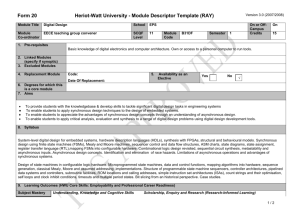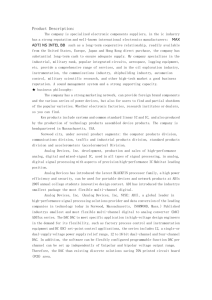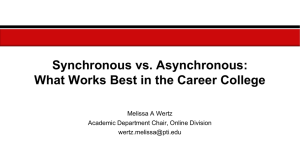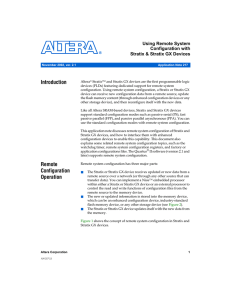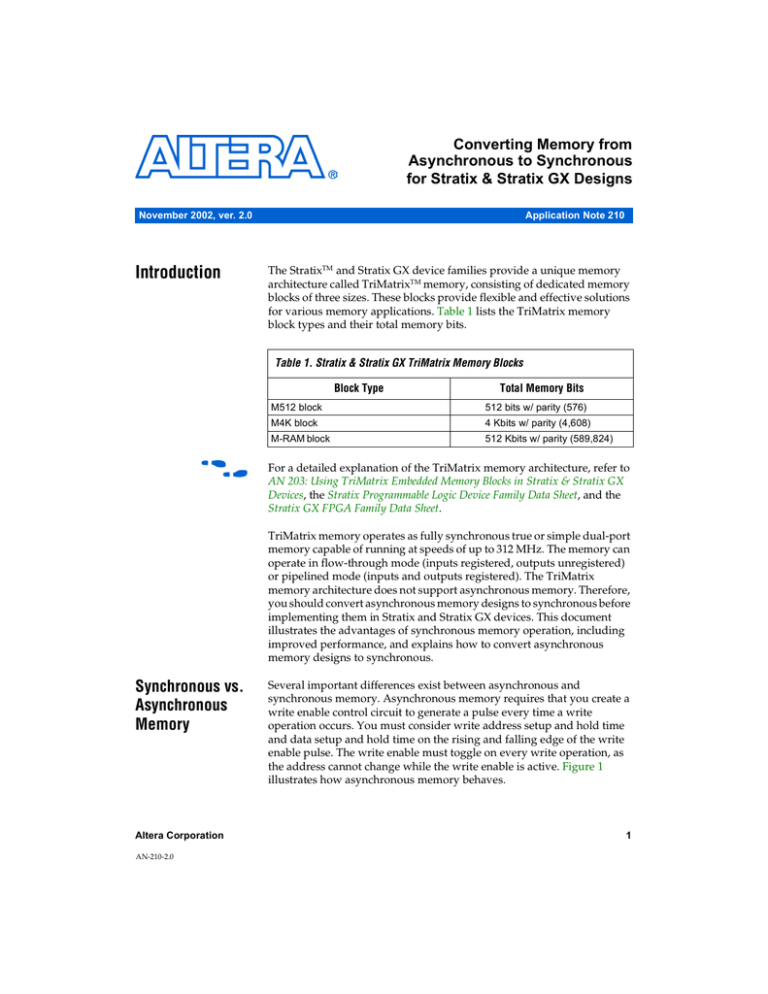
Converting Memory from
Asynchronous to Synchronous
for Stratix & Stratix GX Designs
November 2002, ver. 2.0
Introduction
Application Note 210
The StratixTM and Stratix GX device families provide a unique memory
architecture called TriMatrixTM memory, consisting of dedicated memory
blocks of three sizes. These blocks provide flexible and effective solutions
for various memory applications. Table 1 lists the TriMatrix memory
block types and their total memory bits.
Table 1. Stratix & Stratix GX TriMatrix Memory Blocks
Block Type
M512 block
f
Total Memory Bits
512 bits w/ parity (576)
M4K block
4 Kbits w/ parity (4,608)
M-RAM block
512 Kbits w/ parity (589,824)
For a detailed explanation of the TriMatrix memory architecture, refer to
AN 203: Using TriMatrix Embedded Memory Blocks in Stratix & Stratix GX
Devices, the Stratix Programmable Logic Device Family Data Sheet, and the
Stratix GX FPGA Family Data Sheet.
TriMatrix memory operates as fully synchronous true or simple dual-port
memory capable of running at speeds of up to 312 MHz. The memory can
operate in flow-through mode (inputs registered, outputs unregistered)
or pipelined mode (inputs and outputs registered). The TriMatrix
memory architecture does not support asynchronous memory. Therefore,
you should convert asynchronous memory designs to synchronous before
implementing them in Stratix and Stratix GX devices. This document
illustrates the advantages of synchronous memory operation, including
improved performance, and explains how to convert asynchronous
memory designs to synchronous.
Synchronous vs.
Asynchronous
Memory
Altera Corporation
AN-210-2.0
Several important differences exist between asynchronous and
synchronous memory. Asynchronous memory requires that you create a
write enable control circuit to generate a pulse every time a write
operation occurs. You must consider write address setup and hold time
and data setup and hold time on the rising and falling edge of the write
enable pulse. The write enable must toggle on every write operation, as
the address cannot change while the write enable is active. Figure 1
illustrates how asynchronous memory behaves.
1
AN 210: Converting Memory from Asynchronous to Synchronous for Stratix & Stratix GX Designs
Figure 1. Asynchronous Memory Behavior
Data
Setup
Data
Hold
Data
Address
Write
Enable
Write
Address
Setup
Write
Address
Hold
Synchronous memory design offers several advantages over
asynchronous memory design. Simpler timing requirements allow
synchronous memory to operate at much higher frequencies, resulting in
higher memory bandwidth. Synchronous operation is not prone to errors
because signals are registered on clock edges, simplifying the design
process. A write-enable control circuit is not required because the memory
block controls the write strobe generation, saving on resource usage and
simplifying the design. Additionally, synchronous memory consumes
little standby power. Figure 2 illustrates synchronous memory behavior.
2
Altera Corporation
AN 210: Converting Memory from Asynchronous to Synchronous for Stratix & Stratix GX Designs
Figure 2. Synchronous Memory Behavior
Clock
Setup Hold
Data
Address
Write
Enable
In many designs, even if the memory is asynchronous, the modules the
memory interfaces with are synchronous, making the conversion to
synchronous memory design straightforward. Registers in the data path
would move into the memory block, having a negligible effect on
functionality.
Synchronous
Memory Design
In synchronous memory operation, the TriMatrixTM memory architecture
receives a system clock to control read and write operations. The
TriMatrix memory block uses one or more system clocks to generate a selftimed intra-block write pulse strobe. This strobe writes to the memory
without toggling the write enable (WE) signal. Since the intra-block pulse
toggles, the address lines can change while the WE signal is active,
allowing multiple writes to different addresses. The memory block can
have a zero hold time, symplifying system design.
Synchronous memory can achieve the same or better performance as
asynchronous memory if the data path is pipelined and the design is
modified to compensate for the additional pipelined stages.
You can emulate the behavior of asynchronous memory by choosing an
appropriate clock frequency such that the output of the Stratix or
Stratix GX memory block behaves similarly to the output of the
asynchronous memory. Figure 3 illustrates the Q output behavior of the
memory block when it is asynchronous (Q-Async), clocked on the positive
edge (Q-Sync), and clocked on the negative edge (Q-Sync_N).
Altera Corporation
3
AN 210: Converting Memory from Asynchronous to Synchronous for Stratix & Stratix GX Designs
If the asynchronous memory is in a registered data path as shown in
Figure 3, you can make the memory synchronous by using the negative
edge of the clock. The output data that is registered into B will have the
same data Q1 whether it is asynchronous (Q-Async) or synchronous (QSync_N).
Figure 3. Registered Data Path
Note (1)
The same data value Q1 is
registered into B with Q-Async
and Q-Sync_N
Clock
Addr
A1
A2
Q1
Q-Async
Q-Sync
Q-Sync_N
A3
Q2
Q3
Q1
Q2
Q1
Q-Pipe
Q2
Q3
Q1
Q2
The data value Q1 is
available after a one clock
cycle delay with Q-Sync and
Q-Pipe
Q-Async
D
Q-Sync
D
Q
Q
D
Async
Memory
A
B
Q-Sync Registered Data Path
Q-Async Registered Data Path
Q-Pipe
Q-Sync_N
D
D
Q
Q
Sync
Memory
A
B
Q-Sync_N Registered Data Path
Q
Sync
Memory
A
B
D
Q
D
D
Q
A
Q
Sync
Memory
B
Q-Pipe Registered Data Path
Note to Figure 3:
(1)
4
Although Q-Async is not possible in the Stratix or Stratix GX memory block, Figure 3 illustrates this for comparison
purposes.
Altera Corporation
AN 210: Converting Memory from Asynchronous to Synchronous for Stratix & Stratix GX Designs
A designer can use Q-Sync or Q-Pipe to capture the correct data Q1 after
a one clock cycle delay. Using Q-Sync or Q-Pipe increases performance
because the system clock is able to operate at a higher frequency
compared with the Q-Sync_N implementation. For example, if the
registered data path in Figure 4 is set with the parameters specified below,
the maximum performance of the data path is 10 ns for Q-Async.
■
■
■
Delay from A to the memory block = 3 ns
Delay through the memory block = 4 ns
Delay from the memory block to B = 3 ns
Figure 4. Registered Data Path Performance
3 ns
D
4 ns
Q
D
Memory
Block
A
3 ns
Q
B
14 ns
10 ns
7 ns
Q-Async Performance
Q-Sync Performance
7 ns
Q-Sync_N Performance
6 ns
3 ns
Q-Pipe Performance
If the asynchronous memory is replaced with a synchronous TriMatrix
memory block with the same type of system clock, the maximum
performance is 7 ns because of the addition of the input registers (Q-Sync).
If negative-edge clocking is used, system performance decreases as delay
from the negative edge of the clock (memory block) to the positive edge of
the clock (register B) is 7 ns, effectively half a period. This results in overall
performance of 14 ns (Q-Sync_N). If the memory block is pipelined to
include output registers, the system clock performance becomes 6 ns,
because the critical path is from the negative edge of the output register of
the memory to the positive edge of register B.
Altera Corporation
5
AN 210: Converting Memory from Asynchronous to Synchronous for Stratix & Stratix GX Designs
Converting Existing Designs
When migrating designs to Stratix or Stratix GX devices, you must retarget the existing asynchronous memory components to the TriMatrix
memory architecture. Conversion requires careful analysis and
understanding of the memory operation, and some redesign.
Use the following procedure when converting existing asynchronous
memory blocks:
■
■
■
■
f
Recreate the memory function using the MegaWizard® Plug-In
Manager in the Quartus II software (version 2.0 and later) to target
the Stratix or Stratix GX device (Tools menu)
Implement negative edge clocking for asynchronous memory
components
Remove the WE signal control circuit
Verify registered data path behavior
For information regarding the different TriMatrix memory modes and
using the MegaWizard Plug-In Manager to generate memory
components, refer to AN 203: Using TriMatrix Embedded Memory Blocks in
Stratix & Stratix GX Devices.
You must connect the clock port of the new synchronous memory
component to the clock that feeds the registered data path. Implement
negative edge clocking by utilizing a NOT gate primitive to invert the clock
feeding the memory component. You can remove the WE pulse generator
circuit as it is not required for TriMatrix memory blocks.
Once you implement the design changes, verify the behavior of the data
path. Using the Quartus II software or a third-party simulation tool,
perform a timing simulation to verify the functionality of the memory
block. Using the Quartus II or third party timing analyzer, check setup
and hold times to ensure operation at the desired frequency. Many timing
analyzers, including the Quartus II timing analyzer, automatically take
positive or negative clocking of a register into account when computing
the maximum frequency.
Verify the maximum frequency (fMAX) of the clock feeding the registered
data path. If there is a timing violation, or the desired performance is not
achieved, further redesign is required. Adding pipelined stages and
redesigning the system to accommodate the cycle latency associated with
additional pipelining can increase performance.
Starting New Designs
When starting a new design that will utilize TriMatrix memory, consider
the following:
6
Altera Corporation
AN 210: Converting Memory from Asynchronous to Synchronous for Stratix & Stratix GX Designs
■
■
Specifications of the memory’s performance and behavior
Analysis of the data path
Determine the type of memory (single-port ROM, dual-port RAM, etc.)
required for the application and the required performance of the memory
block. Use the MegaWizard Plug-In Manager to create the appropriate
memory function.
f
For more information on Stratix and Stratix GX memory megafunctions,
see the Altera web site (www.altera.com).
Next, consider the performance required from the available memory
block and system clocks. If the desired clock frequency is not available,
use the PLLs in the Stratix or Stratix GX device to generate the required
clock from one of the system clocks. Consider the number of pipelined
stages required to achieve the desired performance. The rest of the design
must compensate for the cycle latency.
The Stratix and Stratix GX device M-RAM blocks can replace external
memory devices. Use the “Converting Existing Designs” section as a
guideline for replacing asynchronous external memory. Since memoryaccess times will be much faster with on-chip memory, the TriMatrix
memory blocks are able to emulate asynchronous memory in most cases.
Conclusion
Stratix and Stratix GX TriMatrix memory blocks must be synchronous.
Their performance depends on the frequency of the clock source and the
attributes of the data path. It is possible to migrate asynchronous memory
designs to Stratix and Stratix GX devices without sacrificing performance
or creating behavior changes in most cases. The benefits of synchronous
memory designs, such as increased performance and simpler design
process, make the TriMatrix memory block a flexible and effective
solution for on-chip memory applications.
Revision
History
The information contained in AN 210: Converting Memory from
Asynchronous to Synchronous for Stratix & Stratix GX Designs version 2.0
supersedes information published in previous versions. The following
change was made in AN 210: Converting Memory from Asynchronous to
Synchronous for Stratix & Stratix GX Designs version 2.0: added Stratix GX
devices throughout the document.
Altera Corporation
7
AN 210: Converting Memory from Asynchronous to Synchronous for Stratix & Stratix GX Designs
101 Innovation Drive
San Jose, CA 95134
(408) 544-7000
http://www.altera.com
Applications Hotline:
(800) 800-EPLD
Literature Services:
lit_req@altera.com
8
Copyright © 2002 Altera Corporation. All rights reserved. Altera, The Programmable Solutions Company, the
stylized Altera logo, specific device designations, and all other words and logos that are identified as
trademarks and/or service marks are, unless noted otherwise, the trademarks and service marks of Altera
Corporation in the U.S. and other countries. All other product or service names are the property of their
respective holders. Altera products are protected under numerous U.S. and foreign patents and pending
applications, maskwork rights, and copyrights. Altera warrants performance of its
semiconductor products to current specifications in accordance with Altera's standard
warranty, but reserves the right to make changes to any products and services at any time
without notice. Altera assumes no responsibility or liability arising out of the application
or use of any information, product, or service described herein except as expressly agreed
to in writing by Altera Corporation. Altera customers are advised to obtain the latest
version of device specifications before relying on any published information and before
placing orders for products or services
Altera Corporation


